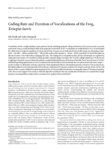1 - 25 of 9
| Creator | Title | Description | Subject | Date | ||
|---|---|---|---|---|---|---|
| 1 |
 |
Olson, Randall J.; Coldwell, Karin D.; Compton, Bruce J.; Giddings, John C. | Sedimentation field-flow fractionation: a method for studying particulates in cataractous lens | It is shown that the technique of sedimentation field-flow fractionation (sedimentation [sed] FFF) can be used to determine the particle content and particle size distribution of normal and cataractous lenses. A 31-year-old normal human lens, for example, showed a particle content of 1.5% by weight ... | Fractionation; Cataractous Lens; Particulates | 1984 |
| 2 |
 |
Baehr, Wolfgang | Tissue-specific expression in transgenic mice directed by the 5'-flanking sequences of the human gene encoding interphotoreceptor retinoid-binding protein | Interphotoreceptor retinoid-binding protein (IRBP) is an extracellular protein that has been suggested to participate in the visual process as a carrier for visual retinoids. A chimeric gene composed of the human IRBP promoter fused to the bacterial reporter gene chloramphenicol acetyltransferase (C... | Restriction Mapping; Nucleic Acid Hybridization; Mice; Gene Expression | 1990-05-25 |
| 3 |
 |
Bastiani, Michael | Loss of axons in the cat optic nerve following fetal unilateral enucleation: an electron microscopic analysis | Between the 48th day of gestation (E-48) and maturity, the number of axons in the cat optic nerve is reduced by approximately 50%. On the basis of an electron microscopic assay, the axon population of the E-48 nerve was estimated to be 328,000. In contrast, estimates from two normal adults were 159,... | Ganglion cell death; Retinofugal projection; Retinal ganglion cell axons | 1983 |
| 4 |
 |
Allen, Edgar S. | Sensory information processing and symbolic computation (1 Jan. 1975 - 30 June 1975) | This research uses digital computation to investigate processes, both linear and nonlinear, for the filtering. restoration, enhancement, bandwidth reduction, distortion immunization and analysis of both visual and auditory information. | Sensory information processing; Symbolic computation; Auditory information; Visual information | 1973 |
| 5 |
 |
Jorgensen, Erik | Neural plasticity | Neural plasticity refers to functional changes in the nervous system and therefore encompasses a range of phenomena from changes at synapses observed on a microscopic scale to changes in behavior observed in the whole animal. These diverse phenomena are related since changes in synapses are believ... | Synapses; Nervous System; Development | 1997 |
| 6 |
 |
Jorgensen, Erik | Caenorhabditis elegans gene unc-25 encodes glutamic acid decarboxylase and is required for synaptic transmission but not synaptic development | The neurotransmitter GABA has been proposed to play a role during nervous system development. We show that the Caenorhabditis elegans gene unc-25 encodes glutamic acid decarboxylase (GAD), the GABA biosynthetic enzyme. unc-25 is expressed specifically in GABAergic neurons. Null mutations in unc-25... | 1999 | |
| 7 |
 |
Olivera, Baldomero M. | Identification and characterization of a Ca2+-sensitive nonspecific cation channel underlying prolonged repetitive firing in Aplysia neurons | The afterdischarge of Aplysia bag cell neurons has served as a model system for the study of phosphorylation-mediated changes in neuronal excitability. The nature of the depolarization generating the afterdischarge, however, has remained unclear. We now have found that venom from Conus textile trig... | Ca21-activated nonspecific cation channel; Slow inward current; Ion channel modulation; Afterdischarge; Bursting; Aplysia bag cell neurons; Conus textile; Neurotoxins | 1996 |
| 8 |
 |
Bastiani, Michael | Pathfinding by neuronal growth cones in grasshopper embryos: II. Selective fasciculation onto specific axonal pathways | In the previous paper (Raper, J. A., M. Bastiani, and C. S. Goodman (1983) J. Neurosci. 3: 20-30) we showed that the growth cones of two sibling neurons, the G and C cells, follow the same route in the developing grasshopper neuropil until they reach a stereotypic choice point. Here their growth con... | Neurons; Axons; Neuropil | 1983 |
| 9 |
 |
Yamaguchi, Ayako | Coding rate and duration of vocalizations of the frog , Xenopus laevis | Vocalizations involve complex rhythmic motor patterns, but the underlying temporal coding mechanisms in the nervous system are poorly understood. Using a recently developed whole-brain preparation from which "fictive" vocalizations are readily elicited in vitro, we investigated the cellular basis of... | 2012-08-29 |
1 - 25 of 9
